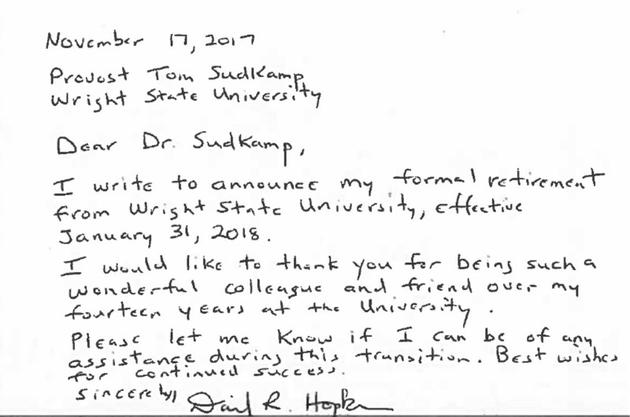
Excerpt from the Dayton Daily News
After 14 years — 10 of them as president — David Hopkins formally retired this week from Wright State University with a short, hand-written note on a napkin-sized piece of paper.
The note, which was addressed to outgoing provost Tom Sudkamp, was dated Nov. 17 but made Hopkins’ retirement official as of Wednesday, Jan. 31. It was obtained on Friday through a Jan. 19 public records request from this news organization.
“I would like to thank you for being such a wonderful colleague and friend over my fourteen years at the university,” said the note to Sudkamp. “Please let me know if I can be of any assistance during this transition. Best wishes for continued success.”
Hopkins’ personnel records show he cashed out $1,791 in vacation pay and $16,156 in sick leave. His salary at retirement was $200,000.
Hopkins resigned from the Wright State presidency on March 17, around three and a half months before he originally planned to retire from the office.
With his resignation as president, Hopkins was set to receive $150,000 in deferred compensation. If he had finished his term as president, Hopkins was to be paid $432,000 for one full year after leaving office, according to his contract.
Hopkins was replaced with interim president Curtis McCray before Cheryl Schrader took over the job on July 1.
Instead of completely leaving the university last March, Hopkins returned to a faculty position, though he never actually taught again at Wright State.
In the last few years of Hopkins’ presidency, Wright State was embroiled in budget issues that led to layoffs and more than $30.8 million in budget cuts last June. Despite the issues that outlasted Hopkins’ term as president, board of trustees chairman Doug Fecher said that Hopkins should be remembered for “all of the good” he was able to accomplish.
“I think Dave did a lot of good for the university. He was the university’s greatest ambassador, and we need to recognize that,” Fecher said. “I don’t think there’s any ill feelings. I think the university is moving on as it should.”
Although Wright State was once a growing and flourishing school under Hopkins, he ended up leaving behind a legacy of mixed results.
After rising to the presidency from the provost position, Hopkins oversaw the construction of the university’s Neuroscience Engineering Collaboration Building, the Student Success Center, the Wright State Physicians building and the expansion of the Creative Arts Center. Hopkins oversaw the university’s “Rise. Shine” campaign, which raised more than $160 million.

